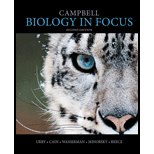
Concept explainers
The immediate energy source that drives ATP synthesis by ATP synthesis during oxidative phosphorylation is the
- A. oxidation of glucose and other organic compounds.
- B. flow of electrons down the electron transport chain.
- C. H+ concentration gradient across the membrane holding ATP synthase.
- D. transfer of phosphate to ADP.
Introduction:
ATP is the energy currency of our body. It is synthesized in the mitochondria by oxidation of glucose (mostly). The process is called oxidative phosphorylation.
Answer to Problem 1TYU
Correct answer:
TCA cycle helps in the production of an electron motive force that is passed along the complexes in the inner mitochondrial membrane (electron transfer chain) and converted to proton motive force. This positive force is then responsible for ATP synthesis. Therefore, option (C) is correct.
Explanation of Solution
Reason for the correct statement:
When the concentration of protons is high outside the membrane of mitochondria, protons are forced through the enzyme ATP synthase. This proton movement makes the ATP synthase to rotate and the production of APT from ADP and inorganic phosphate (Pi).
Option (C) is given as “
“The immediate energy source that drives ATP synthesis by ATP synthase during oxidative phosphorylation is the
Hence, the option (c) is correct.
Reasons for the incorrect statements:
Option (A) is given as “oxidation of glucose and other organic compounds”.
Oxidation of glucose and other organic material actually occurs where the process of ATP synthesis starts; however, it is not the immediate energy source for ATP synthesis. Thus, it is the wrong answer.
Option (B) is given as “flow of electrons down the electron transport chain”.
ETC is responsible for creating the gradient, but it is not the immediate energy source for ATP synthesis. Thus, it is the wrong answer.
Option (D) is given as “transfer of phosphate to ADP”.
The immediate energy source that drives ATP synthesis by ATP synthase during oxidative phosphorylation is the
Hence, options (A), (B), and (D) are incorrect.
Proton gradient created in the inter-membrane space is the reason for ATP generation by enzyme ATP synthase.
Want to see more full solutions like this?
Chapter 7 Solutions
Campbell Biology in Focus (2nd Edition)
Additional Science Textbook Solutions
Physical Science
Genetics: From Genes to Genomes
Campbell Essential Biology (7th Edition)
Microbiology Fundamentals: A Clinical Approach
Human Physiology: An Integrated Approach (8th Edition)
- can you help me identify this it's based on onion rootarrow_forwardWhich evidence-based stress management techniques are most effective in reducing chronic stress and supporting college students’ academic success?arrow_forwardstudents in a science class investiged the conditions under which corn seeds would germinate most successfully. BAsed on the results which of these factors appears most important for successful corn seed germination.arrow_forward
- I want to write the given physician orders in the kardex formarrow_forwardAmino Acid Coclow TABle 3' Gly Phe Leu (G) (F) (L) 3- Val (V) Arg (R) Ser (S) Ala (A) Lys (K) CAG G Glu Asp (E) (D) Ser (S) CCCAGUCAGUCAGUCAG 0204 C U A G C Asn (N) G 4 A AGU C GU (5) AC C UGA A G5 C CUGACUGACUGACUGAC Thr (T) Met (M) lle £€ (1) U 4 G Tyr Σε (Y) U Cys (C) C A G Trp (W) 3' U C A Leu בוט His Pro (P) ££ (H) Gin (Q) Arg 흐름 (R) (L) Start Stop 8. Transcription and Translation Practice: (Video 10-1 and 10-2) A. Below is the sense strand of a DNA gene. Using the sense strand, create the antisense DNA strand and label the 5' and 3' ends. B. Use the antisense strand that you create in part A as a template to create the mRNA transcript of the gene and label the 5' and 3' ends. C. Translate the mRNA you produced in part B into the polypeptide sequence making sure to follow all the rules of translation. 5'-AGCATGACTAATAGTTGTTGAGCTGTC-3' (sense strand) 4arrow_forwardWhat is the structure and function of Eukaryotic cells, including their organelles? How are Eukaryotic cells different than Prokaryotic cells, in terms of evolution which form of the cell might have came first? How do Eukaryotic cells become malignant (cancerous)?arrow_forward
- What are the roles of DNA and proteins inside of the cell? What are the building blocks or molecular components of the DNA and proteins? How are proteins produced within the cell? What connection is there between DNA, proteins, and the cell cycle? What is the relationship between DNA, proteins, and Cancer?arrow_forwardWhy cells go through various types of cell division and how eukaryotic cells control cell growth through the cell cycle control system?arrow_forwardplease make the drawing and steps of whats it asking. thank you!arrow_forward
- please fill in empty spots. thank you!arrow_forwardplease fill in the empty sports, thank you!arrow_forwardIn one paragraph show how atoms and they're structure are related to the structure of dna and proteins. Talk about what atoms are. what they're made of, why chemical bonding is important to DNA?arrow_forward
 Concepts of BiologyBiologyISBN:9781938168116Author:Samantha Fowler, Rebecca Roush, James WisePublisher:OpenStax College
Concepts of BiologyBiologyISBN:9781938168116Author:Samantha Fowler, Rebecca Roush, James WisePublisher:OpenStax College Human Physiology: From Cells to Systems (MindTap ...BiologyISBN:9781285866932Author:Lauralee SherwoodPublisher:Cengage Learning
Human Physiology: From Cells to Systems (MindTap ...BiologyISBN:9781285866932Author:Lauralee SherwoodPublisher:Cengage Learning
 BiochemistryBiochemistryISBN:9781305577206Author:Reginald H. Garrett, Charles M. GrishamPublisher:Cengage Learning
BiochemistryBiochemistryISBN:9781305577206Author:Reginald H. Garrett, Charles M. GrishamPublisher:Cengage Learning Biology (MindTap Course List)BiologyISBN:9781337392938Author:Eldra Solomon, Charles Martin, Diana W. Martin, Linda R. BergPublisher:Cengage Learning
Biology (MindTap Course List)BiologyISBN:9781337392938Author:Eldra Solomon, Charles Martin, Diana W. Martin, Linda R. BergPublisher:Cengage Learning Biology: The Dynamic Science (MindTap Course List)BiologyISBN:9781305389892Author:Peter J. Russell, Paul E. Hertz, Beverly McMillanPublisher:Cengage Learning
Biology: The Dynamic Science (MindTap Course List)BiologyISBN:9781305389892Author:Peter J. Russell, Paul E. Hertz, Beverly McMillanPublisher:Cengage Learning





